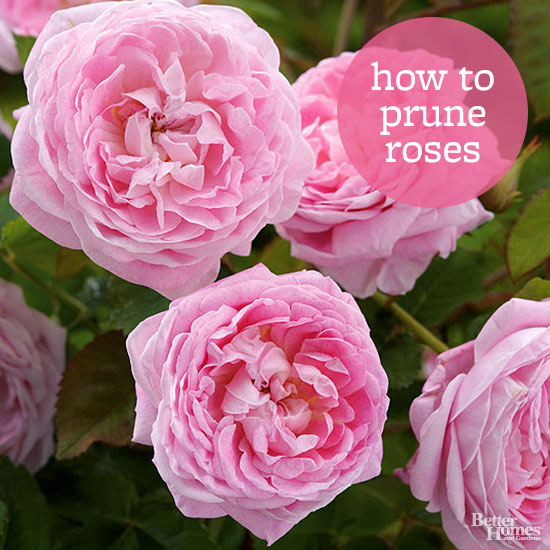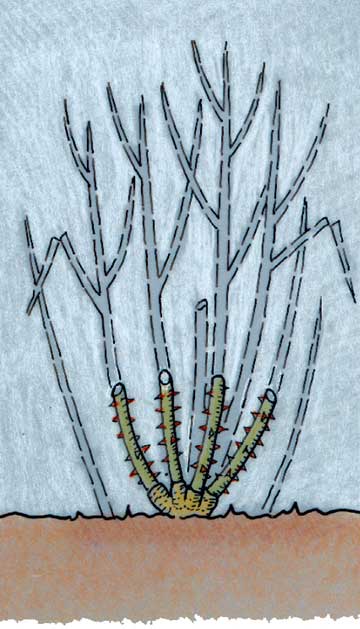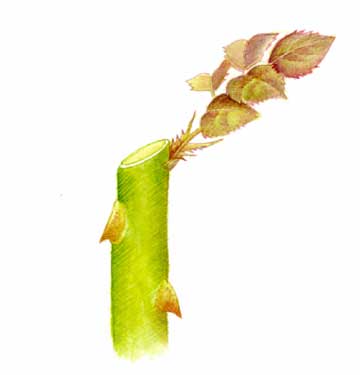






In general, you will be pruning just before the plant breaks dormancy after spring's final frost. This will be early in the year in warm climates, and anytime between January and April in cold climates.
If it's old roses you are tending, prune them after blooming. They bear flowers on last year's wood. Cut away the dead wood first -- it will help you "see" the shape of the plant without distraction. It's a good idea to visit a public rose garden and find specimens of roses you are growing. Note how the gardeners have pruned roses of the same type. In cold-winter climates, pruning is often reduced to one option: Simply cut back the wood that was killed in winter. In warm climates, pruning can be done at any of three levels, depending on your purpose. Severe pruning (cut to leave three or four canes, 6 to 10 inches high) produces fewer but larger blooms. Moderate pruning (five to 12 canes cut to 18 to 24 inches) makes for a larger bush. And light pruning (less than one-third of the plant is thinned out) increases the number of short-stemmed flowers that will be produced.
Find the perfect rose bush in our Plant Encyclopedia.
continue reading below
Invest in a pair of high-quality pruning shears with both blades curved. (Those with a flat "anvil" on one blade tend to crush stems, not cut them.) This is one tool where price really does make a difference. Select a manufacturer with a proven track record, and buy the best that you can afford. Some pruning shears have a special hand grip designed for left-handed people. Others have swivel handles that are easier on your wrists, and there are models with removable blades for storage. Smaller versions (costing about $20) are available for pruning miniature roses. Next, you'll need a pruning saw to remove large woody canes. It will give you a clean cut without damage to the bud union. The third tool you need is a pair of lopping shears. Loppers are pruners with long (12- to 18-inch) handles. They will provide you with leverage for the thicker canes. Finally, buy a good strong pair of leather gauntlet gloves or hand gloves that are puncture proof. Now, you're ready to start pruning.
Get tips for growing heirloom roses.
By fall, miniature roses have grown tall and leggy. Colder evenings produce ill-formed, mottled blossoms and yellowing foliage that often starts to fall off. Rose hips, which can interrupt the next blooming cycle, may result if spent blossoms are not removed. Pruning removes diseased and dead stems and canes and reduces the overall size of the plant. The first spring bloom demonstrates how pruning results in an annual process of renewal.
Learn the right way to feed your roses.
 A hybrid tea before and afterpruning.
A hybrid tea before and afterpruning.
1. Always prune dead wood back to healthy tissue. You will recognize the living tissue by its green bark and white pith core.
2. After you make each cut, cover it with a drop of white glue to ensure quick recovery, as well as provide protection against cane borers.
3. Prune to ensure the center of the bush is open for maximum air circulation.
Learn how to prune roses by type.
4. Remove all growth on the main canes that is not capable of sustaining a reasonably thick stem on its own.
5. If suckers -- growths from the root structure that sprout from below the bud union -- are present, remove them as close to the main root cane as possible.
6. Remove woody old canes; saw them off as close to the bud union as you can get.
7. After you have completed pruning your rose bush, remove any remaining foliage from the canes and clean up debris from around the bush. Discard all foliage (do not use it in the compost heap).

1. Make your pruning cuts at a 45-degree angle, about 1/4 inch above a leaf axle with a dormant eye.
2. Choose an eye on the outside of the cane and slope the cut down and away on the opposite side. This allows excess natural sap to rise and seal the cut without interfering with the developing eye. Pruning to an outward-facing bud also promotes outward growth, opens up the plant to air circulation, creates more pleasing shapes, resists disease, and prevents the canes from becoming a tangle. Cuts closer to the eye than 1/4 inch may damage it. Cuts higher than that will leave a visible stubble -- a haven for both pests and disease.
3. If the rose bush has foliage present, the location for your cut is easy to spot. Where there is no foliage to guide you, find the dormant eye by locating where the foliage was once connected. The eye is normally visible as a slight swelling above the surface of the cane.
4. Use this same pruning technique when cutting stems for display and when removing spent blooms. Remember to sharpen your pruning tools periodically -- either do it yourself or have someone do it who's specially trained.
5. Wipe metal surfaces after each use with a soft, lightly oiled rag to prevent rust. Store tools in a dry area.
Copyright © www.100flowers.win Botanic Garden All Rights Reserved